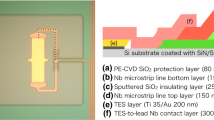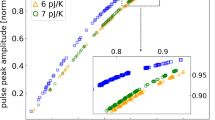Abstract
Superconducting transition-edge sensor (TES) microcalorimeters are being developed for a variety of potential astrophysics missions, including Athena. The X-ray integral field unit instrument on this mission requires close-packed pixels on a 0.25 mm pitch, and high quantum efficiency between 0.2 and 12 keV. In this work, we describe a new approach with 50 μm square TESs consisting of a Mo/Au bilayer, deposited on silicon nitride membranes to provide a weak thermal conductance to a ~ 50 mK heat bath. Larger TESs usually have additional normal metal stripes on top of the bilayer to reduce the noise. However, we have found that excellent spectral performance can be achieved without the need for any normal metal stripes on top of the TES. A spectral performance of 1.58 ± 0.12 eV at 5.9 keV has been achieved, the best resolution seen in any of our devices with this pixel size.




Similar content being viewed by others
References
K. Nandra et al., (2013). arXiv:1306.2307 [astro-ph.HE]
D. Barret et al., Space Telescopes and instrumentation 2014: ultraviolet to gamma ray. Proc. SPIE 9905, 99052F (2016). https://doi.org/10.1117/12.2232432
S.J. Smith et al., Space telescopes and instrumentation 2016: ultraviolet to gamma ray. Proc. SPIE 9905, 99052H (2016). https://doi.org/10.1117/2.2231749
N. Iyomoto et al., Appl. Phys. Lett. 92, 013508 (2008). https://doi.org/10.1063/1.2830665
J. Ullom et al., Appl. Phys. Lett. 84, 4206 (2004). https://doi.org/10.1063/1.1753058
M. Lindeman et al., Nucl. Instr. Methods Phys. Res. A 520, 348 (2004). https://doi.org/10.1016/j.nima.2003.11.264
N.A. Wakeham et al., J. Low Temp. Phys. This Special Issue LTD17 (2018)
J.E. Sadleir et al., Phys. Rev. B 84, 184502 (2011). https://doi.org/10.1103/PhysRevB.84.184502
T. Saab et al., Nucl. Instr. Methods Phys. Res. A 559, 712 (2006). https://doi.org/10.1016/j.nima.2005.12.112
C.N. Bailey et al., J. Low Temp. Phys. 167(3–4), 121 (2012). https://doi.org/10.1007/s10909-012-0562-2
K. Irwin, G. Hilton, C. Enss, Top. Appl. Phys. (2005). https://doi.org/10.1007/10933596_3
N. Iyomoto et al., J. Low Temp. Phys. (2008). https://doi.org/10.1007/s10909-007-9668-3
W. Yoon et al., IEEE Trans. Appl. Supercond. 27, 4 (2017). https://doi.org/10.1109/TASC.2017.2655718
G. Hölzer et al., Phys. Rev. A 56, 4554 (1997). https://doi.org/10.1103/PhysRevA.56.4554
Author information
Authors and Affiliations
Corresponding author
Rights and permissions
About this article
Cite this article
Miniussi, A.R., Adams, J.S., Bandler, S.R. et al. Performance of an X-ray Microcalorimeter with a 240 μm Absorber and a 50 μm TES Bilayer. J Low Temp Phys 193, 337–343 (2018). https://doi.org/10.1007/s10909-018-1974-4
Received:
Accepted:
Published:
Issue Date:
DOI: https://doi.org/10.1007/s10909-018-1974-4




